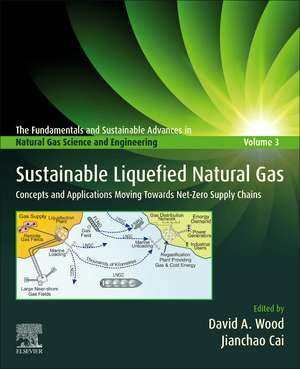Sustainable Liquefied Natural Gas: Concepts and Applications Moving Towards Net-Zero Supply Chains: The Fundamentals and Sustainable Advances in Natural Gas Science and Eng
Editat de David A. Wood, Jianchao Caien Limba Engleză Paperback – 13 feb 2024
Supported by corporate and academic contributors along with two well-distinguished editors, this book provides today’s natural gas engineers the knowledge to adjust liquefied natural gas operations in a more environmentally sustainable way.
- Provides case studies and visuals to illustrate how new principles can be applied in practical situations
- Presents innovative advances that are leading to improved environmental performance
- Bridges theory and applications with methods and examples from worldwide contributors in academia and industry
Preț: 906.58 lei
Preț vechi: 1184.04 lei
-23% Nou
Puncte Express: 1360
Preț estimativ în valută:
173.53€ • 188.55$ • 145.86£
173.53€ • 188.55$ • 145.86£
Carte tipărită la comandă
Livrare economică 14-28 aprilie
Preluare comenzi: 021 569.72.76
Specificații
ISBN-13: 9780443134203
ISBN-10: 0443134200
Pagini: 518
Dimensiuni: 191 x 235 mm
Greutate: 0.89 kg
Editura: ELSEVIER SCIENCE
Seria The Fundamentals and Sustainable Advances in Natural Gas Science and Eng
ISBN-10: 0443134200
Pagini: 518
Dimensiuni: 191 x 235 mm
Greutate: 0.89 kg
Editura: ELSEVIER SCIENCE
Seria The Fundamentals and Sustainable Advances in Natural Gas Science and Eng
Cuprins
Preface
1. LNG: An Evolving Industry with Net-Zero Challenges
Section One: Natural gas liquefaction
2. The evolution of global LNG supply chains: A Review
3. Natural Gas Liquefaction Technologies and Their Uptake in Floating LNG Facilities
4. The core liquefaction facility in FLNG: spiral-wound heat exchanger
5. Australian LNG sector: Struggling to Achieve Commercial and Environmental Sustainability or Community Satisfaction
6. Supersonic separation technology for natural gas dehydration in LNG plants
Section Two: LNG shipping and offshore storage facilities
7. LNG carriers and FSRU: opportunities to improve their operational efficiency
8. Sustainable LNG deliveries and FSRU operations: planning and scheduling simulations
9. Liquefied Natural Gas Cold Energy Utilization Technology Process Efficiency for Floating Regasification Facilities
Section Three: Onshore Storage and Regasification
10. Dynamic simulation models for an LNG storage tank
11. Stratification and rollover behavior of liquefied natural gas in storage tanks
12. LNG rollover monitoring and control associated with floating storage and regasification units (FSRU)
Section Four: Small-scale LNG facilities and operations
13. Safety of LNG bunkering operations and facilities
14. Exploiting cold energy associated with LNG regasification processes
Section Five: LNG markets and utilization
15. LNG Marketization progress in China and its LNG price indexes
16. Carbon-neutral LNG cargoes: a potentially valuable concept requiring improved transparency
1. LNG: An Evolving Industry with Net-Zero Challenges
Section One: Natural gas liquefaction
2. The evolution of global LNG supply chains: A Review
3. Natural Gas Liquefaction Technologies and Their Uptake in Floating LNG Facilities
4. The core liquefaction facility in FLNG: spiral-wound heat exchanger
5. Australian LNG sector: Struggling to Achieve Commercial and Environmental Sustainability or Community Satisfaction
6. Supersonic separation technology for natural gas dehydration in LNG plants
Section Two: LNG shipping and offshore storage facilities
7. LNG carriers and FSRU: opportunities to improve their operational efficiency
8. Sustainable LNG deliveries and FSRU operations: planning and scheduling simulations
9. Liquefied Natural Gas Cold Energy Utilization Technology Process Efficiency for Floating Regasification Facilities
Section Three: Onshore Storage and Regasification
10. Dynamic simulation models for an LNG storage tank
11. Stratification and rollover behavior of liquefied natural gas in storage tanks
12. LNG rollover monitoring and control associated with floating storage and regasification units (FSRU)
Section Four: Small-scale LNG facilities and operations
13. Safety of LNG bunkering operations and facilities
14. Exploiting cold energy associated with LNG regasification processes
Section Five: LNG markets and utilization
15. LNG Marketization progress in China and its LNG price indexes
16. Carbon-neutral LNG cargoes: a potentially valuable concept requiring improved transparency



